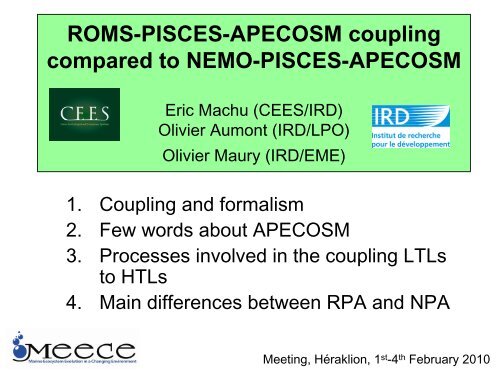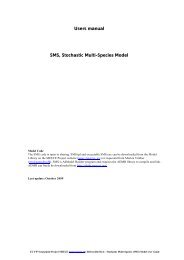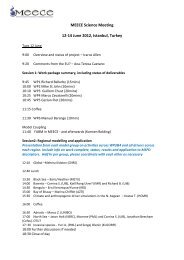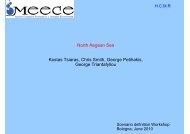ROMS-PISCES-APECOSM coupling compared to NEMO ... - meece
ROMS-PISCES-APECOSM coupling compared to NEMO ... - meece
ROMS-PISCES-APECOSM coupling compared to NEMO ... - meece
Create successful ePaper yourself
Turn your PDF publications into a flip-book with our unique Google optimized e-Paper software.
<strong>ROMS</strong>-<strong>PISCES</strong>-<strong>APECOSM</strong> <strong>coupling</strong><br />
<strong>compared</strong> <strong>to</strong> <strong>NEMO</strong>-<strong>PISCES</strong>-<strong>APECOSM</strong><br />
Eric Machu (CEES/IRD)<br />
Olivier Aumont (IRD/LPO)<br />
Olivier Maury (IRD/EME)<br />
1. Coupling and formalism<br />
2. Few words about <strong>APECOSM</strong><br />
3. Processes involved in the <strong>coupling</strong> LTLs<br />
<strong>to</strong> HTLs<br />
4. Main differences between RPA and NPA<br />
Meeting, Héraklion, 1 st -4 th February 2010
Formalism coherence<br />
Hydrodynamics: Primitive equations for describing the motion<br />
Navier-S<strong>to</strong>kes<br />
Forcing<br />
Advection-diffusion equations<br />
For T & S<br />
Dissipation<br />
Equation of state<br />
Boussinesq approximation<br />
Incompressible fluid
Biogeochemistry: Primitive equation for describing the evolution of<br />
concentrations<br />
Forme, taille et<br />
fonctionnement<br />
fortement<br />
variable ...<br />
Advection<br />
Vertical<br />
Diffusion<br />
Horizontal<br />
Diffusion<br />
Source-minus-Sink<br />
terms
Open Ocean Pelagic Communities: Primitive equation for<br />
describing the energy content in each community (epipelagic,<br />
migrants & mesopelagic)<br />
∂<br />
t<br />
ξ<br />
i<br />
=<br />
div<br />
− ∂<br />
−<br />
(<br />
i i i i<br />
) (<br />
i i i i<br />
)<br />
x,y<br />
d ∇<br />
x,yξ<br />
− v ξ + ∂<br />
z<br />
d<br />
z∂<br />
zξ<br />
− vzξ<br />
(<br />
i ii<br />
)<br />
w<br />
γ ξ<br />
Growth<br />
( λ<br />
i + m + s<br />
i ) ξ<br />
i<br />
Sink terms: preda<strong>to</strong>ry, non-preda<strong>to</strong>ry & starvation<br />
] w , w ] ( 0, t )<br />
in Ω× ×<br />
egg<br />
max<br />
Diffusion /<br />
Advection terms<br />
max<br />
γ<br />
Reproduction<br />
Boundary condition in size<br />
( x,<br />
y,<br />
z,<br />
t) ∈ Ω [ 0 ]<br />
c<br />
t, x,<br />
y,<br />
z,<br />
w<br />
ξt,<br />
x,<br />
y,<br />
z,<br />
w<br />
= rt<br />
, x,<br />
y,<br />
z<br />
∀<br />
,<br />
, t<br />
×<br />
egg egg<br />
max
Energy<br />
<strong>NEMO</strong>- <strong>PISCES</strong>-<strong>APECOSM</strong><br />
PAR<br />
Predation<br />
Nanophy<strong>to</strong>plank<strong>to</strong>n 1-10 mm<br />
Dia<strong>to</strong>ms 10-100 mm<br />
Micro-zooplank<strong>to</strong>n<br />
Mesozooplank<strong>to</strong>n<br />
Predation<br />
Fishes<br />
NH4 +<br />
NO -<br />
3<br />
Mortality<br />
Weight<br />
Excretion<br />
t, x, y, z<br />
P.O.M.<br />
Egestion<br />
This formalism insures rigorous<br />
mass-conservation<br />
&<br />
have predictive skills
Few words about <strong>APECOSM</strong><br />
Units<br />
• Biogeochemistry: Concentrations µmol.l-1<br />
Redfield ratio: C/N/P=106/16/1<br />
Fe, Si and Chl are prognostically predicted based on external<br />
concentrations of the limiting nutrients like in the quota approach<br />
(McCarthy, 1980; Droop, 1983)<br />
• Open Ocean Pelagic Communities: Energy J.m -3 .kg -1<br />
Conversion [N] or [C] --> E (J.N/C-mol -1 )<br />
Redfield + biomass free energy=474.6 kJ.C-mol-1<br />
N_E_convert: 3144225 – C_E_convert: 474600.
Mean Individual<br />
Bioenergetics<br />
Parameters<br />
ORGANISM<br />
ingestion<br />
assimilation<br />
PREYS<br />
Simplified from Kooijman, 2000<br />
Structure<br />
growth<br />
K<br />
κ<br />
1-κ<br />
somatic<br />
growth<br />
maintenance<br />
gonadic<br />
maintenance<br />
reproduction<br />
1-K<br />
reproduction<br />
Eggs<br />
Preda<strong>to</strong>r/Prey interactions<br />
Selectivity<br />
Prey length (m)<br />
Preda<strong>to</strong>r<br />
length (m)
~ 20 Parameters (Maury et al., PiO, 2007)
Outputs from the model<br />
Different carrying<br />
capacities<br />
Carrying capacity<br />
oscillation (one year)<br />
and propagation<br />
Maury, Prog. Oceanogr., 2007
Key references for each model<br />
• <strong>ROMS</strong>: Shchepetkin & McWilliams (OM, 2005)<br />
• <strong>PISCES</strong>: Aumont & Bopp (GBC, 2006)<br />
• <strong>APECOSM</strong>: Maury et al. (PiO, 2007)
Coupling Higher Trophic Levels <strong>to</strong><br />
physical/biogeochemical models<br />
Processes<br />
• Effect of temperature on metabolic rates: rate ( T) = rate ( )<br />
T ref<br />
e<br />
⎛<br />
⎜<br />
T<br />
⎝<br />
T<br />
A<br />
ref<br />
T<br />
−<br />
T<br />
A<br />
⎞<br />
⎟<br />
⎠<br />
• Effect of light on ecosystem dynamics through the habitat of epipelagic,<br />
migra<strong>to</strong>ry and mesopelagic communities<br />
• Hydrodynamic advection and diffusion added <strong>to</strong> active swimming<br />
d<br />
⎧<br />
⎪u<br />
⎪<br />
⎨<br />
⎪<br />
⎪v<br />
⎪⎩<br />
i<br />
2<br />
3<br />
( 1 ⎛<br />
2 ∇f<br />
⎞<br />
i<br />
i<br />
, , , ,<br />
, , , , 1 2 , , , ,<br />
) ⎜<br />
t x y z w ⎛<br />
1<br />
⎟ w<br />
⎟ ⎞<br />
⎜<br />
t x y z w<br />
= d + d − ft<br />
x y z w<br />
−<br />
⎜<br />
i<br />
k + ∇f<br />
⎟<br />
, , , , ⎝ w<br />
food t x y z w max ⎠<br />
i<br />
t , x,<br />
y,<br />
z,<br />
w<br />
i<br />
t , x,<br />
y,<br />
z,<br />
w<br />
=<br />
=<br />
MSS<br />
MSS<br />
max<br />
max<br />
i<br />
( 1−<br />
f )<br />
t , x,<br />
y,<br />
z,<br />
w<br />
i<br />
( 1−<br />
f )<br />
t , x,<br />
y,<br />
z,<br />
w<br />
⎛<br />
⎜<br />
⎜<br />
⎝<br />
k<br />
⎛<br />
⎜<br />
⎜<br />
⎝<br />
k<br />
⎝<br />
food<br />
food<br />
∂<br />
∂<br />
x<br />
+<br />
y<br />
+<br />
f<br />
f<br />
i<br />
t , x,<br />
y,<br />
z,<br />
w<br />
∇f<br />
i<br />
t , x,<br />
y,<br />
z,<br />
w<br />
∇f<br />
i<br />
t , x,<br />
y,<br />
z,<br />
w<br />
i<br />
t , x,<br />
y,<br />
z,<br />
w<br />
⎞<br />
⎟⎛<br />
⎜<br />
⎟<br />
⎠⎝<br />
⎞<br />
⎟⎛<br />
⎜<br />
⎟<br />
⎠⎝<br />
w<br />
w<br />
max<br />
w<br />
w<br />
max<br />
⎞<br />
⎟<br />
⎠<br />
⎞<br />
⎟<br />
⎠<br />
1<br />
3<br />
1<br />
3<br />
⎠<br />
+ cz<br />
+ cm<br />
t,<br />
x,<br />
y,<br />
z<br />
t , x,<br />
y,<br />
z<br />
f = Holling type 2<br />
functional response<br />
Dependence on<br />
size
Energy<br />
<strong>NEMO</strong>- <strong>PISCES</strong>-<strong>APECOSM</strong><br />
PAR<br />
Predation<br />
Nanophy<strong>to</strong>plank<strong>to</strong>n 1-10 mm<br />
Dia<strong>to</strong>ms 10-100 mm<br />
Micro-zooplank<strong>to</strong>n<br />
Mesozooplank<strong>to</strong>n<br />
Predation<br />
Fishes<br />
NH4 +<br />
NO -<br />
3<br />
Mortality<br />
Weight<br />
Excretion<br />
t, x, y, z<br />
P.O.M.<br />
Egestion<br />
• Feedback of predation of pelagic communities on au<strong>to</strong>trophs &<br />
microzooplank<strong>to</strong>n?<br />
• Role of mortality, excretion and egestion on particulate organic<br />
matter?
Size<br />
Fishing<br />
Focus<br />
species 2 Focus<br />
Focus<br />
species 1<br />
species 3<br />
Focus<br />
species 4<br />
x, y, z<br />
Primary<br />
production<br />
Biomass<br />
• Address bot<strong>to</strong>m-up vs <strong>to</strong>p-down control of pelagic exosystems<br />
• Final goal: understand end-<strong>to</strong>-end dynamics of marine<br />
ecosystems
Coupling Higher Trophic Levels <strong>to</strong><br />
physical/biogeochemical models<br />
Technical informations<br />
• The development of <strong>ROMS</strong>-<strong>PISCES</strong>-<strong>APECOSM</strong> takes<br />
advantage of <strong>NEMO</strong>-<strong>PISCES</strong>-<strong>APECOSM</strong> developments<br />
• <strong>APECOSM</strong> coded in C/C++ but for computing cost<br />
reasons, the model has been changed <strong>to</strong> fortran<br />
(although the C/C++ <strong>coupling</strong> option is not given up)
• Source-minus-sink terms for Open Ocean Pelagic<br />
Communities (OOPC) are solved in 3D<br />
• Physical advection and diffusion are solved in 2D<br />
(implicitely 3D since currents are weighted by energynormalized<br />
profile)<br />
• Time steps of the hydrodynamic model are split in<strong>to</strong> a<br />
day and a night fraction (dependent on latitude and<br />
season) mainly because preda<strong>to</strong>r/prey interactions<br />
depend on day and night
step.F<br />
step3d_t (advection followed by biogeochemical SMS terms)<br />
step2d_oopc (Apecosm SMS terms followed by advection<br />
t3dmix (tracer mixing)<br />
oopc2d_mix (oopc mixing)<br />
step2d_oopc :<br />
bridge_oopc<br />
calc_habitat (3D projection of 2D OOPC variables)<br />
do dn=0,1<br />
ff_updt (flux feeding)<br />
calc_pred (predation mortality, source & sink terms related <strong>to</strong><br />
growth: excretion, egestion, maintenance, reproduction)<br />
if dn=1 : growth (growth advection term, starvation, nonpreda<strong>to</strong>ry<br />
mortality)<br />
calc_adv (Compute u_active, v_active and biological diffusion)<br />
calc_meso (meso computed from oopc size spectra)<br />
updt_bgc (update bgc variables)<br />
enddo<br />
do dn=0,1<br />
calc_vmoy (Vertical average <strong>to</strong> advect and diffuse 2D OOPC variables)<br />
enddo<br />
Compute horizontal advection (U+U_active)<br />
Compute horizontal diffusion (Diff+biological Diff)<br />
oopc2dbc (treatment of the boundary conditions)
Main differences between RPA and NPA<br />
(appart from the hydrodynamic model itself)<br />
• Order of operations<br />
• Advection/Diffusion numerical schemes<br />
• RPA needs oceanic boundary conditions (advection of<br />
conservative quantities) which will be provided by NPA
Future<br />
• Set-up regional configurations (Benguela & Bay of<br />
Biscay) (rely on existing configurations)<br />
• Carry on sensitivity analyses<br />
• Validate the annual cycle of model outputs<br />
(mesozooplank<strong>to</strong>n, ecosystem energy slopes, …)<br />
• Derive process studies from scenarios definition (no<br />
interannual run planned)<br />
• Represent targeted species like anchovy and<br />
sardine (probably post-<strong>meece</strong> …)








